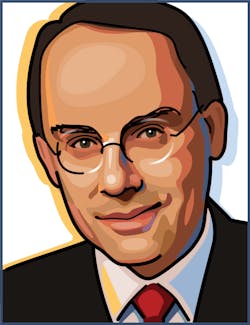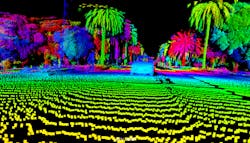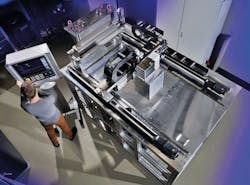
The year is ending, holiday reminders surround us, and after some opulent dinner it is time to think about what may come to us next year. A few trends in photonics such as lidar or additive manufacturing are obvious, others may be less apparent. Here are my picks for photonics trends that might be worth watching in 2018.
2017 was an incredible year for industrial photonics: Market leaders such as Trumpf and IPG Photonics posted double-digit revenue growth, and Coherent seems to do well with the purchase of Rofin Sinar. It is no surprise that fiber lasers conquered more than 40% market share, while the good news for excimer lasers may not be on everybody‘s focus. And thanks to EUV the good old CO2 laser has some new prospects as well.
Behind many of the good numbers is a record breaking spending of almost $56 billion for equipment in semiconductor industry. The CEO of Carl Zeiss, Michael Kaschke, spoke of “the most successful fiscal year in the history of Zeiss,” backed by a 25% increase of the SMT division, which mainly delivers into the semiconductor industry.
Think big: Lidar
There is no need to consult with glass balls or the dubious remains in my coffee mug to predict the future of lidar. While this technology has been around for decades to analyze the distribution of gases and pollutants in the atmosphere, it has become a crucial technology for autonomous driving in recent years. A short Google research reveals a list of more than 50 companies active in this market.
One indicator for the importance of lidar might be the M&A activity. When GM bought the 11-person startup Strobe in October it wasn’t the first and certainly not the last deal in the field. GM is targeting to become a vertically integrated company for autonomous driving. Another well supported company, Alphabet’s Waymo, announced similar intentions. Lighting giant Osram bought a 25% stake in Leddartech, and Ford’s self driving unit Argo acquired Princeton Lightwave.
So 2017 was a year of many new partnerships and investments for autonomous driving, but the most interesting question remains: When will it come to the store near you? Jason Eichenholz from Luminar sees that coming in 2021, while his company is already ramping up for large scale manufacturing in 2018. And so does Velodyne, one of the market leaders in this game.VCSELs on the rise
Another interesting trend is VCSELs. These vertical-cavity surface-emitting lasers received some attention recently when Apple announced it is investing $390 million in VCSEL-maker Finisar. While VCSELs have been used in the iPhone 8 (mainly from Lumentum), Apple announced more to come: “In the fourth quarter of 2017, Apple will purchase 10 times more VCSEL wafers than were previously manufactured worldwide over a similar time period.” The technology gives a cheap and integrated solution for depth sensing and, hence, for 3D image acquisition. We see it in smartphones now, but this might be just the beginning.
Additive manufacturing
The best place to see the progress in additive manufacturing was certainly the Frankfurt tradeshow formnext, held in November. With more than 21,000 visitors and 470 exhibitors in its third year, it reached an audience similar to established trade shows such as SPIE Photonics West.But this reflects just the general trend of 25% CAGR for (laser-based) additive manufacturing over the last five years, as Arnold Mayer from Optech Consulting confirmed to me last week. The Boston Consulting Group forecasts even 30% annual growth in a larger market review on Industrialized Additive Manufacturing.
Basic research: Make America great again?
The headlines for quantum technologies were big in 2017: Using their Micius (or Mozi) satellite, the Chinese achieved quantum encrypted communication over a distance of a 1200 km. They established a network of five ground stations to communicate with Micius. These connect to a 2000-kilometer fiber optic backbone between Beijing and Shanghai (completed in 2016). They made the first satellite-based quantum key distribution to start an encrypted video conversation with the wise man of quantum communication, Anton Zeilinger, in Vienna, Austria.
What does that mean for my forecast? In 2018, the call for funding applications within the European €1 billion Quantum Technology Flagship will start. This comes along with approximately two dozen national initiatives. In China there will be ongoing strong governmental funding plus private money: In October 2017, the Alibaba group announced their plans to invest more than $15 billion over three years in researching emerging technologies including artificial intelligence and quantum computing.
In the U.S., the National Photonics Initiative released a whitepaper calling for a National Quantum Initiative and $500 million funding. This led to a hearing in the U.S. House of Representatives titled American Leadership in Quantum Technologyon October 24.
And there was one more outcry of American scientists. On the December 12, the American Society for Mechanical Engineers (ASME) in Collaboration with the National Photonics Initiative (NPI) hosted a Congressional briefing, “Lasers for America: Driving Advancements in Science, National Security, Manufacturing, Health and U.S. Competitiveness.” The background is well described in a 280-page report of the National Academies of Sciences, Engineering, and Medicine.
This initiative is focused on high-intensity ultrafast lasers. For the past several decades this field has been led by American laboratories, but as the study points out, this has changed. Currently, 80-90% of existing high-intensity laser systems are overseas, and all the highest power research lasers currently in construction or built are overseas as well. This year the first systems of the European Extreme Light Infrastructure ELI started operations. In 2018 ELI will start to distribute beam time since this is a user facility mainly for external researchers.
The ELI investment of roughly €1 billion is leading to a new generation of high intensity laser systems. It aims for higher intensities, higher repetition rates, and ever shorter pulses at reduced energy consumption.
While it may look like pure basic research at first, the European Union as well as the U.S. National Academy of Sciences, Engineering and Medicine see a strong impact on the applicational side: For example, laser-based particle accelerators may provide new radiation sources for medical treatments. The high repetition rate high energy systems can lead to a new generation of efficient material processing devices.
And after all, this new infrastructure as well as similar projects in Asia will draw the attention of young talent. Already, the ELI project employs almost 1000 people on various places. It will be very interesting to follow up on the American reactions in 2018.
So 2018 will be a very interesting year. While most of the industry is flourishing, it looks as if some decisions in basic research may change (or retain) the picture of our community for decades. If you are looking for more details, you may come to SPIE Photonics West. Besides thousands of interesting presentations and a number of highly interesting industry events, you may find more specific market data at the Laser Focus World Lasers & Photonics Marketplace Seminar.

Andreas Thoss | Contributing Editor, Germany
Andreas Thoss is the Managing Director of THOSS Media (Berlin) and has many years of experience in photonics-related research, publishing, marketing, and public relations. He worked with John Wiley & Sons until 2010, when he founded THOSS Media. In 2012, he founded the scientific journal Advanced Optical Technologies. His university research focused on ultrashort and ultra-intense laser pulses, and he holds several patents.

